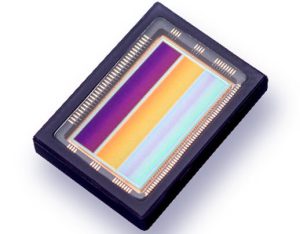It had equidistantly divided spectral bands and, compared with its previous generation, more uniform* filter transmission efficiency and double* the TDI (time-delayed-integration) capacity – to 10 digital TDI stages per band.
Underneath the filter is a ‘2/3inch’ 2,048pixel image sensor from AMS – the CMV2000 which operates at up to 340frame/s at full resolution.
Multiple regions-of-interest can be defined on the sensor – allowing the sensor to be operated at full spectral resolution or to select specific bands to reduce its data rate, increase frame-rate or reduce noise.
“By integrating thin-film filters monolithically onto the AMS sensor, unlike set-ups that place separate optical elements between the lens and sensor, the design guarantees an exceptional filter to detector alignment and is resistant to shocks, vibrations, and temperature fluctuations,” said Imec.
The sensor is available off-the-shelf for individual purchase units, or supply agreements can be signed for larger quantities.
Applications are foreseen in satellites monitoring food systems, agriculture, biodiversity, water quality, air quality and mining.
* Electronics Weekly has requested technical clarification about these and other performance claims made by Imec – watch this space if this might be important to you.
Find SmallSat 2024 here
Starting as a semiconductor research lab in Belgium, Imec has grown into a €941m revenue (P&L) technology company with 5,500 employees and researchers, covering: nm-class process scaling, silicon photonics, artificial intelligence, beyond-5G comms and sensing technologies. It also studies applications including: health, life sciences, mobility, industry 4.0, agrofood, smart cities, sustainable energy and education. Imec has additional sites in the Netherlands and the US, and remains headquartered in Leuven.

